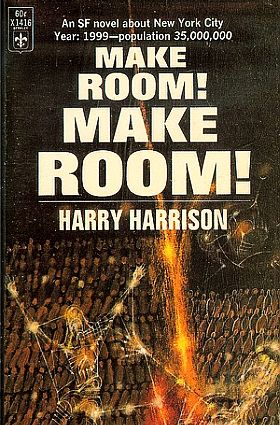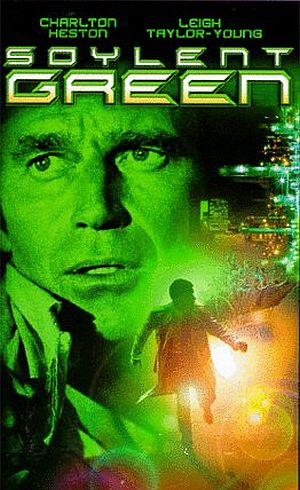In April 1973, a film named Soylent Green was released in America starring actors Charlton Heston, Edward G. Robinson, Chuck Connors, Joseph Cotten and Leigh Taylor-Young. In the film, it is the year 2022, and the world has gone to hell. After years of runaway population growth, the planet is a mess, pollution is rampant, and resource scarcity is a way of life. New York city, the place where this story unfolds, houses some forty million people. The city is shrouded in a dense yellow haze of pollution as an ongoing heat wave torments its occupants. Poverty abounds and every available space is crammed with desperate residents. Corporations run all the services, such as they are.
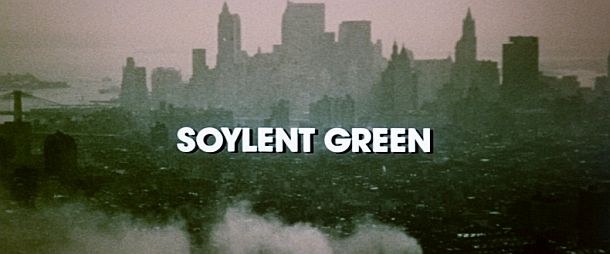
Opening screen shot from the 1973 film “Soylent Green,” depicting a polluted and overheated New York City.
The teeming masses survive by way of generic food products produced by the Soylent Corporation. The highly processed wafers, distributed on specified week days, are known by names such as “Soylent Yellow” and “Soylent Red.” But in the year 2022, a new Soylent product is introduced – “Soylent Green” – made from ocean plankton. Real food – such as vegetables and meat – have long vanished, save for a few last remnants, now black-market fare and eaten only by the ultra-rich. Running water too, is virtually unknown, as residents stand in long lines for their water ration.
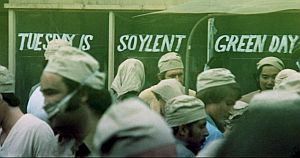 "Tuesday is Soylent Green Day," the day small food wafers made from ocean plankton are distributed to the masses. |
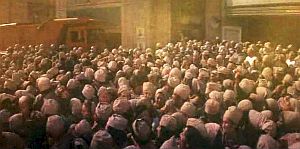 Angry masses often turn violent during Soylent food days. |
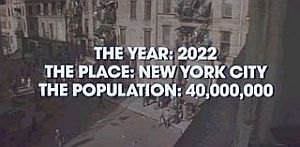 One of the film’s opening screenshots set the stage on the crowded, run-down nature of a dystopic New York City. |
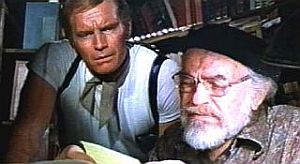 Charlton Heston as detective Robert Thorn, and Edward G. Robinson as Solomon “Sol” Roth, live together in their cramped apartment in the 1973 film, “Soylent Green.” |
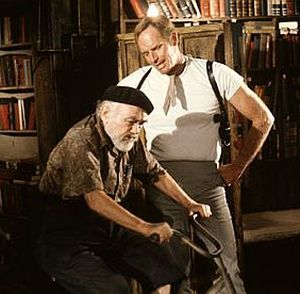 Sol and Thorn in conversation while Sol pedals a bike to charge up their generator for electricity. |
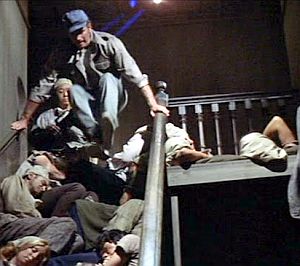 Thorn jumping over local “residents” who now sleep and live in the stairwell outside Thorn & Sol’s apartment. |
 Thorn on the scene of the suspected murder of William Simonson, who later turns out to be part of Soylent Corp. Tab Fielding, the bodyguard, played by Chuck Connors, looks on. |
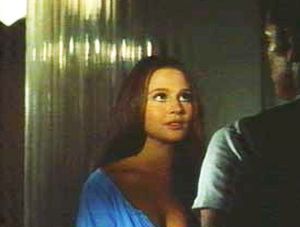 “Apartment woman” Shirl – also called “furniture,” since such ladies came with the property, rented out to tenants. She is questioned by Thorn in his murder investigation. |
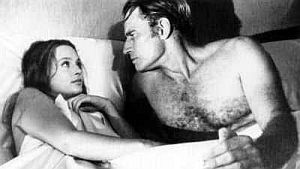 Shirl at first becomes a casual acquaintance for Thorn, but their relationship takes a more serious turn during the story. |
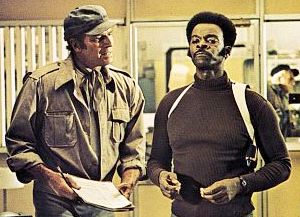 At police headquarters, Thorn visits with chief detective Hatcher (Brock Peters) to go over the Simonson case. |
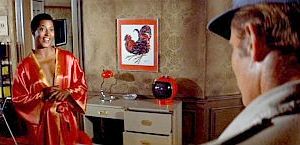 Thorn’s investigation takes him to Fielding’s apartment where he finds Fielding’s companion, Martha Philips. |
 On his way out, Thorn pockets Martha's spoon. |
 Sol brings out the linen & silverware for the ‘special meal’ he has made of the rare food items Thorn pilfered. |
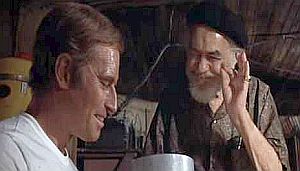 Sol wishing ‘bon apetit’ to Thorn as he offers his beef stew for their special meal. |
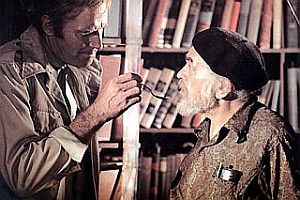 Sol tasting & identifying the red substance Thorn pilfered from Fielding’s lady – rare & expensive strawberry jam. |
 Thorn visits with Father Paul in attempt to learn what Simonson might have told him. |
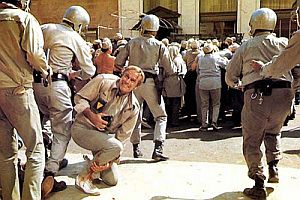 Thorn on riot control duty, where a sniper tries to kill him. |
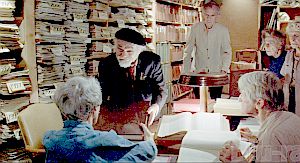 Sol at "Supreme Exchange," where fellow "books" concur with Sol's worst-case discovery. |
Riots over these conditions are frequent and the massed crowds are confronted crudely by riot control police and bulldozer-like equipment called “scoops” which do just that, scooping up and dumping the unruly mobs into trucks to cart them off. This world is also highly bifurcated, with the very rich in walled-off and security-protected buildings, while the masses live in the proletarian district separated from the rich. Most people eke out meager existences, living in the streets, sleeping in churches, cars and building hallways and staircases.
Thorn & Sol
In this dystopic setting, a story unfolds around the lives of Robert Thorn, played by Charlton Heston and his elderly roommate, Solomon “Sol” Roth, played by Edward G. Robinson. Thorn is a detective and Sol is a crime research assistant and one of the few people who can still read. Sol is also old enough to remember how things once were, and how beautiful the planet was.
As it is, living in their resource-scarce and broken-down world, either Sol or Thorn must pedal a stationary bike rigged to a generator to make electricity for their apartment. Outside their door, in the hallway and stairwell, dozens of squatters live and sleep there since they have nowhere else to go.
Thorn and Sol get along with each other fine. Thorn is street-savvy detective not above pilfering a few things from a crime scene now and then to make his and Sol’s life bearable. Sol is frequently reminding Thorn of how good and beautiful the world was “before things went bad.”
Sol is a “Book”
Their apartment is full of books Sol has collected, since books are no longer made. Sol in fact, is called a “book” – a “police book” to be exact.
Electronic databases have long vanished in this world, so folks like Sol who can read and research at “old world” book exchanges, are sometimes employed to help run down what information they can. Sol helps Thorn with his criminal investigations.
“Roth is the film’s heart and soul,” wrote one reviewer in 2011 of Soylent Green, commenting on Edward G. Robinson’s character. “His nostalgic yearnings for the pre-eco-meltdown world still act as a mindful warning to this day…”
Sol has a high regard for the old world and its beauty, if not for its people. “People were always rotten,” he says to Thorn at one point, “but the world was beautiful” – suggesting nature’s recuperative and even “safety-valve” aspects, now gone.
Thorn is an interesting, mixed character, as played by Heston, a swaggering, tough, and street-wise detective, but still retaining his humanity
Murder Investigation
Thorn becomes involved in a murder investigation of a wealthy businessman named William R. Simonson, played by Joseph Cotton. At first the murder appears to be a burglary gone wrong. But as the investigation proceeds it becomes clear Mr. Simonson was deliberately murdered.
Simonson’s “tough guy” bodyguard, Tab Fielding, played by Chuck Connors, seems to be hiding something. At the murder scene – an exclusive residence for the ultra rich – Thorn goes over the site thoroughly, and questions Fieldling about what he knows.
In an earlier set-up scene for viewers, the murderer, named Gilbert, has met with an unnamed person in one of the thousands of abandoned cars that litter the city. He has been hired to kill Simonson – a corporate VIP who has become a security risk of some unstated kind.
Gilbert fulfils his murder contract, gaining entry to Simonson’s normally-secure upper class, luxury apartment, killing him with a meat hook.
“Furniture Girl”
At his apartment, Simonson had a live-in lover, a female attendant who comes with the apartment – referred to as “furniture” or “apartment women” – rented out to rich tenants. Simonson’s female companion is named Shirl, played by Leigh Taylor-Young.
In his investigation, Thorn questions Shirl about Simonson and the apartment, but she knows nothing about the murder or any motive. She does say that Simonson was a kindly man, who did seem bothered about something in recent days.
Simonson, it is later learned, was a member of the board of directors of the Soylent Corporation, and was also involved in politics, associated with the current governor, named Santini.
Luxury Goods
While Thorn is in Simonson’s apartment, with all of its luxuries, he washes his face with running water, something he’s barely experienced before. He also helps himself to some of the apartment’s luxury food items — alcohol, soap, a few books, and other incidentals. He also becomes intimate with the apartment girl, Shirl.
Thorn returns home with his bundle of pilfered food and other supplies from Simonson’s apartment and presents them to Sol. In addition to items such as pencils and real sheets of paper, it is the even rarer food items that get Sol’s undivided attention – an onion, an apple, and a side of beef – the latter of which is now worth a small fortune.
Upon seeing the real food Thorn has brought home, Sol nearly comes to tears remembering the old days. There is also some whiskey.
Oceanographic Survey
In addition, Thorn gives Roth the Soylent Oceanographic Survey Report: 2015 to 2019,, a two-volume work which he liberated from Simonson’s apartment. Thorn wants Sol to delve into these reports to learn all he can about them and whether they have anything to do with the murdered Simonson. Then Thorn is off to police headquarters
In a meeting with his supervisor, chief detective Hatcher, played by Brock Peters, Thorn acknowledges he’s having difficulty closing out one of his cases. Hatcher suggests that Sol might be the problem, and maybe he should replace Sol with a new “book,” citing Sol’s age.
Thorn disagrees, and turns to the current murder case. Thorn believes Simonson was assassinated, as nothing was stolen from the apartment and the alarm system was conveniently out of order. Thorn believes Tab Fielding, Simonson’s assistant, is somehow involved.
He later follows Fielding and gains access to his apartment building, but finds that Fielding’s live-in companion, Martha Philips, is the only one at home. After admiring the spacious apartment and wondering how Fielding affords it, Thorn leaves, but on his way out he pilfers a spoon covered with a red substance that Phillips was eating during Thorn’s visit.
“Gourmet” Meal
At home, Thorn discovers that Sol has whipped up a “gourmet” meal from the stolen food items Thorn had brought home earlier. Meager as it is, the “real food” luncheon is something of revelation to Thorn.
Sol treats the occasion with high honor, bringing out real silverware and spreading a linen tablecloth. The main course is a beef stew, served with wine, and a couple of apples. Thorn has never had most of this real food.
Over dinner, Sol reveals from his research of Simonson that he worked for a large legal firm related to the Santini family – that of Governor Santini. Simonson later became director of a freeze-drying food company that was eventually bought by the Soylent Corporation, with Simonson thereafter becoming a member of the Soylent Corporation’s board of directors.
Strawberry Spoon
At the end of the meal, Thorn produces the spoon that he took from Fielding’s apartment with a bit of the mysterious red substance still on it. He offers it to Sol for a taste. Sol exclaims that it’s strawberry jam, a rare delicacy in their world, then selling for upwards of $150 a jar.
Thorn later returns to Simonson’s apartment to visit with Shirl again. She wants to leave Simonson’s apartment and live with Thorn. But that night they stay in the apartment, turn up the air conditioning – “like it was winter again” – avail themselves to the running water and showers, and generally indulge in the luxury apartment’s amenities.
Shirl, meanwhile, has mentioned to Thorn that she and Simonson went to a local church where Simonson had prayed with, and possibly confessed to, a black priest there named Father Paul. Thorn later visits with Father Paul, who is reluctant to divulge any confidential religious conversations he may have had with Simonson.
The powers that be, meanwhile – including Governor Santini – become upset after learning that Thorn now knows about and has talked with the priest. Hatcher, being pressured by higher ups, later tells Thorn that he’s been taken off the Simonson case and assigned to riot control. But Thorn continues his investigation anyway. Tab Fielding, in the employ of the powers that be, later kills Father Paul in his confessional.
Out on the street, during a riot outbreak where Thorn’s unit is involved, the hitman who murdered Simonson tries to kill Thorn, but instead, the would-be assassin is killed by a falling object during the riot. Thorn was grazed in the leg by the hit man’s bullet, but is o.k..
In the next days, Thorn’s investigation continues, as Sol’s research, begins turning up some odd details.
“Oceans Are Dead”
To his great horror, Sol has discovered, after reading the Soylent Corp documents, that “the oceans are dead” – and worse.
Sol then takes Soylent’s oceanographic reports to a like-minded group of researchers at the “Supreme Exchange,” a library and gathering place for fellow “books.”
The “books” and Sol finally realize that the reports indicate a “horrible” truth. They agree that the oceans are no longer capable of producing the plankton from which Soylent Green is reputedly made, and they conclude it is being made instead from – horror of horrors – human remains.
The appalling nature of what Sol has uncovered in Simonson’s Soylent documents and other sources leaves him shaken and depressed.
Alone in his apartment, contemplating what he has learned, he writes a short note for Thorn and leaves it at their apartment – “I’m going home” it says. This is a Soylent Green world euphemism for cashing oneself in — i.e., government-assisted euthanasia.
Sol has decided to turn himself in for “processing” at one of the government “death centers,” though they are not called that in the film.
“Going Home”
Given that starvation and misery of every imaginable kind are a way of life in this world, the state makes it easy, and even inviting, for those who have simply had it with their grim existence, to avail themselves to the state-assisted euthanasia “going home” services – or what some might call “death centers.”
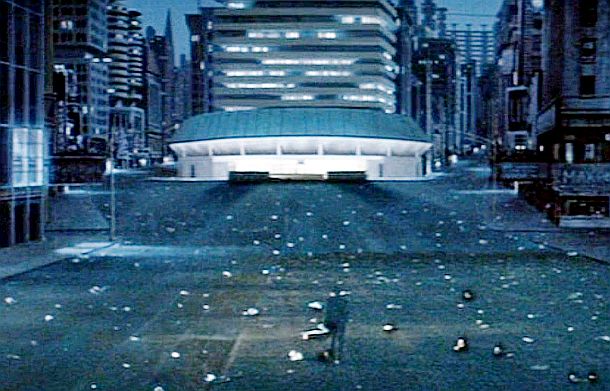
Scene from “Soylent Green” showing a lone person in the middle of the grimy city, heading toward one of the “going home” centers, where state-assisted suicide is offered as an inviting alternative to the misery of living.
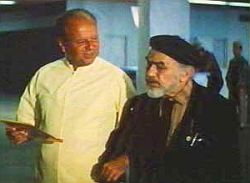
Sol with intake attendant at the “going home” center.
The film shows Sol on a lonely walk down an abandoned street in the middle of the night on his way to the huge and well-lit death center.
Thorn meanwhile, has returned to their apartment only to finds Sol’s note that he is “going home.” Knowing exactly what that means, Thorn races from the apartment in an attempt to reach the “clinic” to prevent Sol from going through with the procedure.
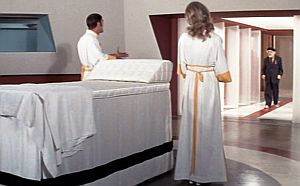 Death chamber attendants welcome Sol to his bier. |
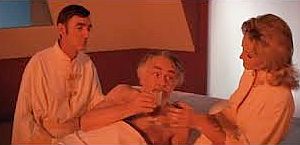 Sol being given “going home” beverage at the death center. |
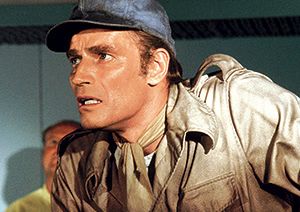 Thorn struggles with attendant (left, over shoulder) to stop process, but is unable, though he forces attendant to open a window to view and talk with Sol as he dies. |
 Sol on his bier at the death center, viewing “forbidden” scenes of nature during his “going home” send off. |
Sol, however, was already well into the process by then.
Upon arriving at the center, he was greeted by a courteous and welcoming attendant – played by Dick Van Patten (above photo) – who guides him through the process..
Sol then makes his way to a preparation room. While there, his clothing is taken and he is places on a bier.
At this point he is also given the sedating drink that is a lethal death potion. It will work slowly on him while he is wheeled into a huge cathedral like room.
Thorn, meanwhile, in a frantic search for his friend, has arrived at the center in an attempt to save Sol. However, he arrives too late, as the process has already begun.
Outside the room where Sol has already been admitted for his final passage, Thorn has accosted a guard trying to force him to stop the process. But the process can’t be stopped once it’s begun.
However, Thorn prevails upon the attendant to allow him to view Sol on his bier in the amphitheater- like chamber, and he also talks with Sol over a speaker system as the process goes forward.
Death Scene
The film sequence at the “going home” center, featuring Sol’s final moments, is regarded as one of the all-time classic death scenes in modern film history. The lighting and colors used, the music, the camera shots of Sol’s face, and the poignancy of what he and Thorn see there, make it a top-rated movie scene.
As Sol lies atop his bier he is surrounded by giant, building-size movie screens. The euthanasia death chamber was conceived as a sort of super-IMAX movie theater where previously “forbidden” images of forests, rushing rivers, and majestic mountains flash before the eyes of the departing in their final moments before death.
As Sol Roth is dying, he watches the giant screens as a sequence of film clips show the earth as it was long ago, when there was lush plant life, endless fields of flowers, multitudes of birds and mammals, no pollution, and no global warming.
Evocative Music

Gigantic film screen dwarfs Sol on his death bier (at center) as filmed images of the old “beautiful world” are shown accompanied by Tchaikovsky, Beethoven, and Grieg..
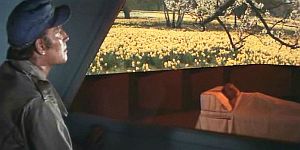
Thorn, looking in on Sol, is enraptured by the scenes of the old beautiful world he has never known.
Music Player
Classical Medley
Tchaikovsky, Beethoven & Grieg

During his final moments, Sol urges Thorn to follow the disposition of his body after it leaves the death center.
“I tried to tell you,” Sol says to Thorn, about the world’s beauty. Thorn acknowledges the beauty, he too is seeing on the screen, “I know, I know you did.” He and Sol exchange their love for one another as Sol continues to view the panorama as he slowly slips away.
In real life, Edward G Robinson died just 12 days after the filming of Soylent Green in January 1973. When the film aired some years later on the TCM channel, it was revealed in background that Robinson had only told Heston, a personal friend, that his doctors had given him just weeks to live. Robinson told Heston this news shortly before the filming of Sol’s death scene, which reportedly affected Heston’s on-screen performance during that scene.
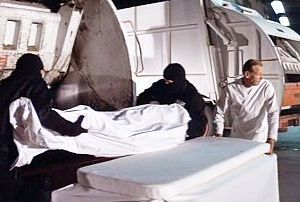 As Thorn follows Sol’s body from inside the death center he discovers that the bodies are trucked away. |
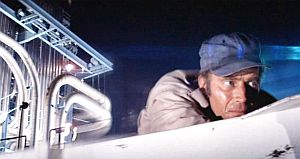 Jumping onto the roof of one of the trucks, Thorn is following the bodies and he soon arrives at a factory-like setting. |
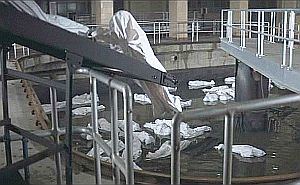 Inside the factory, Thorn discovers that the bodies are eventually dropped into a vat of dark liquid. |
 As Thorn travels through the factory, he learns how the remains are turned into Soylent Green wafers, but he is soon running for his life, pursued by guards and others. |
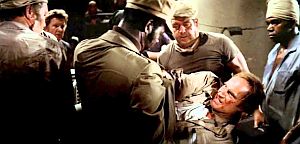 Thorn on stretcher after gun battle, pleads with Hatcher to spread the truth about Soylent Green . |
 Thorn’s final words, near death, “Soylent Green is people!” |
Follow The Bodies
During Sol’s final moments in the film, he tells Thorn the secret of Soylent Green, and begs him to follow the fate of his body once it leaves the death center. Sol also asks Thorn to report what he finds to the “Supreme Exchange.” As he nods off on his bier, Sol’s final words are mixed and incomplete:
…Horrible. Simonson. Soylent. Listen to me, Thorn. Thorn, listen….You’ve got to prove it, Thorn. Go to the Exchange. Please, Thorn. You’ve got to prove it. Thorn. The Exchange.
Although Thorn is shaken and torn by the death of Sol, he heeds Sol’s request to follow the movement of Sol’s body. Thorn sneaks into the basement there, where he sees corpses being loaded onto waste disposal trucks. He then jumps onto the roof of one as it departs from the center.
After a time he arrives at a factory where the sheet-wrapped bodies are placed on conveyor belts. There, they wend their way through a labyrinth of pipes and factory apparatus, at one point dropping, one by one, into a liquid vat, as if being buried at sea. But these bodies are not being buried.
As Thorn makes his way through the factory, he is confronted by security guards, and a battle ensues. After a tussle sending Thorn onto a conveyor belt below – a belt that is full of Soylent Green wafers – Thorn escapes from the factory, killing one of the guards.
Thorn by this time has figured out what’s going on at the factory, but now he’s on the run for he knows the dreadful secret of the Soylent Corporation, and why all the high-powered killing has been going on.
In an alleyway, he phones Shirl and tells her that he loves her but that she should stay in her apartment arrangement with the new incoming tenant, and “just live,” as he is not sure he will survive, given what he now knows.
Gun Battle & Fight
Tab Fielding and accomplices are now after Thorn, and Thorn calls Hatcher for help. In a gun battle, Thorn is shot by Fielding, but not killed, continuing a struggle with Fielding that spills over into a local church filled with the sick and dispossessed. In a gritty battle with Fielding, Thorn manages to kill him with a knife.
Hatcher then arrives to help Thorn, who is bloodied from the fight and near death. Thorn is then put on a stretcher.
“You Gotta’ Tell ‘Em”
But as Hatcher approaches him, Thorn pulls him close and tries to tell Hatcher what he’s discovered and that Hatcher needs to spread the word:
…I’ve got proof Hatcher… I’ve seen it happening. You gotta tell them, Hatcher…. The ocean is dying, plankton is dying. There is no plankton. Soylent Green is made out of people….They’re making our food out of people… Next thing you know, they’ll be breeding us like cattle for food. You better tell them …Listen to me Hatcher, you gotta tell them! We got to stop them somehow… Soylent Green is people…”
That line became one of the classic surviving moments from the film, as more than 30 years later, in 2005, it was voted at No. 77 on AFI’s list of famous movie lines, “100 Years, 100 Quotes.” And in the final scene, as Thorn is carried out on the stretcher amid the destitute crowd of souls huddled in the church, he repeats his cry, raising his bloodied arm and calling out, “Soylent Green is people!” Yet as the film ends, there is no assurance that Thorn’s words are believed or heeded by Hatcher or anyone else, likely dismissed as the paranoid ravings of just another lunatic.
Harrison’s Book
Soylent Green was based on Harry Harrison’s novel, Make Room! Make Room! first published in 1966. Harrison offered a dark and gloomy tale of a future New York City – set in August 1999, then 33 years away – where unchecked global population growth is savaging overcrowded cites, also plagued by resource shortages and crumbling infrastructure.
Harrison’s story, with its food riots, water shortages, pollution, and rampant crime, is set in a New York city with 35 million people. The plot features and follows several individual characters, recounting their lives as they struggle to survive.
The book was one of the first to feature overpopulation as a pressing issue. The cover of the Doubleday hardback edition (first cover at left) was pretty tame, adding a subtitle, “A Realistic Novel of Life in 1999.” A 1967 paperback edition had a little more of a science fiction look to it, with a top-of-the-cover tagline that read: “An SF novel about New York City, Year:1999 – Population 35,000,00.” Remember that these taglines were written more than 50 years ago!
Heston Backs Film

Once the film came out, "Make Room! Make Room!" was issued in a 'Soylent Green' version with Heston and Leigh Taylor-Young on the cover.
In August 1971 Heston had a discussion with Walter Mirisch of MGM for several possible movies, including one on Make Room! Make Room! Those discussions continued through to May 1972, with Walter Seltzer – with whom Heston had worked on several earlier films. One worrisome cost factor centered on the huge numbers of expensive extras that would be needed to do the urban population and crowd scenes. Still, by then a script had been produced.
MGM meanwhile, proposed to change the title for the film from Make Room! Make Room! to Soylent Green, a change Heston supported. The title change was prompted in part by possible confusion with a TV sit com of that day, Make Room for Daddy. Richard Fleischer agreed to direct the film in late June 1972, and casting went forward as well, with Heston pushing for Edward G. Robinson in one of the key roles. Soylent Green began shooting on September 5th, 1972.
At the movie’s release in 1973, the reviews were tepid at best, with Time magazine calling it “intermittently interesting” and New York Times critic A.H. Weiler saying the film’s 21st-century verion of New York City was “occasionally… frightening,” but not always “convincingly real.” Still, in 1973, the film won the Nebula Award for Best Dramatic Presentation and the Saturn Award for Best Science Fiction Film.
Charlton Heston, meanwhile, perhaps better known in his science fiction roles for the Planet of the Apes films, noted in one 1985 British TV interview that those films were basically “just a fantasy.” Soylent Green, on the other hand, focused on a major problem. “I think the population problem is the greatest problem the world faces,” Heston said at the time. “If we do not solve population, never mind any of the rest – never mind civil rights; never mind nuclear power; never mind the environment – it’s all finished. And, of course, that’s what Soylent Green was about. I’m very glad we made that, and very glad it was a success.”Soylent Green by today’s movie-making standards may not offer the most sophisticated treatment of the dystopic themes it raises, or their possible root causes. Still, it has its prescient moments, touching on present-day concerns such as global warming, polluted and dying oceans, overcrowded cities, the widening rich-poor chasm, the remoteness and unaccountability of ever-enlarging food corporations, and the emergence of a politically-corrupt corporate state.
See also at this website, “Max Headroom, 1984-1988″ (a story about a briefly popular sci-fi TV show where a wise-cracking computer-generated being brings a measure of levity to an otherwise dystopic world where the media is a particularly sinister force). Other stories of possible interest can be found at the “Environmental History” page and the “Business & Society” page. Film and publishing-related stories can be found, respectively, at the “Film & Hollywood” page or the “Print & Publishing” page. Thanks for visiting – and if you like what you find here, please make a donation to help support the research and writing at this website. Thank you – Jack Doyle
|
Please Support Thank You |
____________________________________
Date Posted: 16 July 2016
Last Update: 16 July 2022
Comments to: jdoyle@pophistorydig.com
Twitter: https://twitter.com/PopHistoryDig
Article Citation:
Jack Doyle, “Soylent Green: 1973,”
PopHistoryDig.com, July 16th, 2016.
____________________________________
Sources, Links & Additional Information
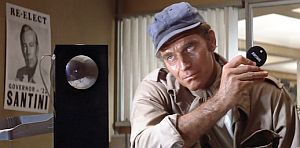 Unhappy detective Robert Thorn at police headquarters where a “Re-Elect Governor Santini” poster is visible. |
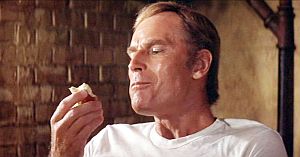 Thorn savoring the crunch and sweetness of a ripe apple for the first time in his life, a rare “real food” item. |
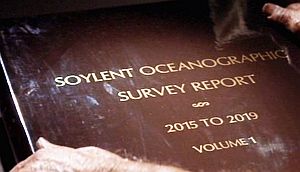 Damning report: “Soylent Oceanographic Survey Report, 2015 To 2019, Volume 1.” |
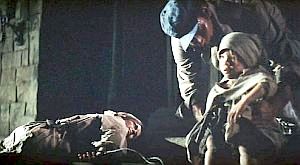 Thorn happens upon a mother who has died on church steps with her child tied to her arm, hoping the child will be cared for. Thorn brings the child inside to care givers. |
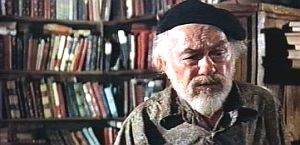 Unhappy Sol, once he has learned about the dying oceans and what the Soylent Corp. is really up to. |
“Soylent Green, Film Summary,” American Film Institute, AFI.com.
Jeff Stafford, Film Review, “Soylent Green (1973),” Turner Classic Movies.
“Soylent Green (1973): Synopsis,” IMDB.com.
“Soylent Green,” Wikipedia.org.
A.H. Weiler, “Soylent Green (1973),” New York Times, April 20, 1973.
Harry Harrison “A Cannibalized Novel Becomes Soylent Green,” in Danny Peary (ed.) Omni’s Screen Flights/Screen Fantasies, New York: Doubleday, 1984.
Leigh Taylor Young, “LTY in 1970’s Soylent Green,” LeighTaylorYoung.com.
Boris Lugosi, “Review of Soylent Green,” Girls, Guns and Ghouls, January 9, 2007.
Charlton Heston Fan, “Soylent Green ‘Symphony Suite’ 1973,” YouTube.com, Uploaded. May 15, 2010.
**“Life vs. ‘Expediency’: Thoughts on Soylent Green,” Notes Toward an International Libertarian Eco-Socialism, July 13, 2010.
Neil Mitchell, “Review of Soylent Green,” Electric Sheep Magazine (U.K.), October, 12, 2011.
“Screen Captures, Soylent Green,” Pyxurz.Blogspot.com, October 2011.
Robin, “Environmental Nostalgia in Soylent Green,” Eco-Cinema and Film Genre, Monday, December 12, 2011.
Christopher Priest, “Harry Harrison Obituary; Popular Author of Science Fiction with a Serious Purpose and a Subversive Wit,” The Guardian (London), August 15, 2012.
James Meikle, “Death of Harry Harrison, Science Fiction Author, Aged 87 Writer of Comic and Dystopian Novels Who Inspired the Film Soylent Green,” The Guardian (London), August 15, 2012.
“Charlton Heston and Soylent Green,” HarryHarrison.com, 2012.
“Make Room! Make Room!,” Wikipedia.org.
B. Shapiro-Hafid, “Make Room! Make Room! And The Politics of Contraception,” A Study of The Hollow Earth, July 24, 2013.
“Luxury Foods, Lunch Scene, Soylent Green,” YouTube.com.
“Soylent Green – Death Center Scene”(3:31), YouTube.com.
“Thorn in Soylent Green Factory,” YouTube .com.
“Soylent Green is People!,” YouTube.com.
David Munk, “Standing Ovation: Edward G. Robinson in ‘Soylent Green’,” Backstage, April 7, 2014.
John Kenneth Muir, “Cult-Movie Review: Soylent Green (1973),” Reflections on Film and Television, June 6, 2014.
Cassidy Ward, “Is Eating People a Solution to World Hunger? The Science Behind ‘Soylent Green’. It’s People! (But It’s Also a Bad Idea),” SyFy.com, February 16, 2022.
________________________________

